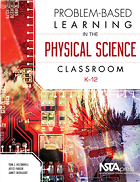Problem-Based Learning: An Essential Tool in Each K-12 Science Educator’s Toolkit
By Carole Hayward
Posted on 2018-09-19
 Problem-based learning (PBL) is a strategy that is tailor made for teaching science. Under the PBL framework, students actively drive the learning process, one that takes them through rich and authentic, but incompletely defined, scenarios. This educational approach requires students to collaborate with others to analyze the problem that’s presented, ask questions, propose hypotheses, identify the information needed to solve the problem, and seek related information via literature searches and scientific investigations.
Problem-based learning (PBL) is a strategy that is tailor made for teaching science. Under the PBL framework, students actively drive the learning process, one that takes them through rich and authentic, but incompletely defined, scenarios. This educational approach requires students to collaborate with others to analyze the problem that’s presented, ask questions, propose hypotheses, identify the information needed to solve the problem, and seek related information via literature searches and scientific investigations.
Implementing PBL for the classroom, however, can be challenging for science educators as curriculum resources are hard to find. That’s one of the reasons why veteran science educators Tom McConnell, Joyce Parker, and Janet Eberhardt teamed up to write Problem-Based Learning in the Physical Science Classroom. This book first takes readers through the overall PBL structure and discusses how it can be applied to the K-12 classroom. Then the authors share a collection of PBL problems which were developed by content experts who participated in the PBL Project for Teachers, a National Science Foundation –created professional development opportunity that used the PBL framework to help science educators develop a deeper understanding of science concepts across eight different content strands.
The authors also ensured that the problems they included are useful to science educators by including information that aligns the objectives and learning outcomes for each problem with the NGSS—and can be taught to learners with differing levels of prior knowledge.
The book’s chapters are arranged as follows:
- Chapter 1 discusses why PBL should be an essential tool in each teacher’s teaching toolbox. The authors provide background on how PBL was developed, how it works across a range of disciplines, and the basic framework for a PBL lesson.
- Chapter 2 covers the alignment of the PBL problems and the analytical framework of the NGSS.
- Chapter 3 takes science educators through strategies for facilitating the PBL lessons.
- Chapter 4 shares tips on how teachers can group students, manage information, and assess student learning throughout the process.
- Chapters 5-8 present designed and tested problems (describing motion, forces and motion, engineering energy transformations, or engineering, electricity and magnetism), show the NGSS alignment, and provide teacher and student resources about the science concept and the problem.
The authors readily acknowledge there are far more science problems that the 14 that they present in this book that would make excellent PBL topics. That’s why they included a final chapter, one that shares strategies for teachers to write their own PBL lessons and offer tips for creating problems that are “rich, engaging, and ideal for addressing the standards you need to teach.”
This book is the third volume in NSTA’s PBL series, the first of which presented life science problems and the second volume that offered problems specifically written for teaching Earth and space science.
“There is a lot to like about this text,” said Peggy Ertmer, professor emeritus of Learning Design and Technology at Purdue University, and founding editor of the Interdisciplinary Journal of Problem-Based Learning. “Implementing PBL is difficult for teachers, and few curriculum guides are available to support their efforts. This book fills that gap by providing the kinds of strategies and examples teachers need to facilitate open-ended inquiry in science classrooms.”
Read the free sample chapter, “Facilitating Problem-Based Learning,” to understand how to help students: function in a self-directed classroom; establish discussion guidelines and procedures, launch the problem, and generate hypotheses; develop a plan for gathering information; and share what they found. Teachers are given helpful information on how to assess their students’ learning and how to use the assessment results to respond to student needs.
This book is also available as an e-book. It’s also available as part of a set of three books: Problem-Based Learning in the Earth and Space, Life Science, and the Physical Science Classroom, K-12.
Follow NSTA
Disclaimer: The views expressed in this blog post are those of the author(s) and do not necessarily reflect the official position of the National Science Teaching Association (NSTA).

